Author: Evan Lu, Waterdrip Capital
Since the Ordinals protocol gained immense popularity in 2023, it has sparked a vigorous construction of the BTC ecosystem, which has completed in just a year and a half the evolutionary path that ETH took over many years. By the end of Q1 this year, the 1.0 phase of the BTC ecosystem is gradually coming to a close. BTC's price has also changed from the usual summer slump, continuously breaking through $110,000 and $120,000 per coin, reaching new all-time highs; however, the market performance of tokens related to the BTC ecosystem on exchanges has been less than satisfactory. A technology's journey from proposal to development, implementation, and widespread adoption cannot be completed in just one year. Not to mention the practice of new technologies on the largest value storage network, BTC.
Observing the different technological paths of the BTC ecosystem, we can see that we are still in a developmental phase. The true prosperity of the BTC ecosystem is still far from being realized. Therefore, the competition for the BTC L2 route has only just begun.
BTC Ecosystem 1.0 and 2.0
Since BTC has been widely recognized as "digital gold," why is there still a need to promote the development of the BTC ecosystem? This is because the scripting language of the BTC network itself is extremely simplified, combined with the PoW consensus mechanism, which ensures a very high level of security and decentralization; however, it also limits Bitcoin's scalability and programmability. As the underlying anchor asset of the entire crypto industry, BTC still has a significant amount of value that has yet to be fully released. Imagine if only 10% of BTC (approximately 2.1 million coins) were used for DeFi, at a price of $100,000 per coin, it would release up to $210 billion in asset liquidity!
From the perspective of ecosystem composition, the BTC ecosystem can be divided into the infrastructure layer (L2) and the upper financial protocols (BTCFi); the following will mainly focus on the interpretation and comparison of the BTC infrastructure technology paths.
In the 1.0 era of the BTC ecosystem, its typical feature is "TVL first" — first transferring BTC to the L2 network through asset bridges or custodians, and then deploying DeFi protocols on L2 to activate BTC's liquidity. This was also the early play of ETH sidechains, with Polygon being a well-known representative; this is also very friendly to crypto users coming from the ETH era, as the logic is essentially EVM's L2 — only the underlying network is BTC, so this technological path can quickly accumulate funds and user bases; however, the shortcomings are particularly obvious: the security of BTC assets cannot be guaranteed.
The 2.0 era of the BTC ecosystem returns to the innovation of technological essence: how to achieve breakthroughs in security, efficiency, and native compatibility. From the launch of the Lightning Network's mainnet to the active promotion of technologies like ZK Rollup, RGB, and BitVM, we see more and more projects beginning to explore how on-chain native assets can achieve safer, more efficient, and more native yield and circulation on L2. For developers, this means a more promising space for innovation; for VCs, this represents an important turning point for the BTC ecosystem from "valuation-driven" to "PMF-driven."
Overview of BTC L2 Technology Pathways
Based on the existing technology stack, several technology pathways can be categorized as shown in the table below. However, if we delve deeply into each technology path and the projects they represent, we will find that even different technology paths may share the same solutions, and there may be subset relationships between different technologies and stacks.

Comparison of different technology paths of BTC L2, data source: https://worried-eagle-e5b.notion.site/BTC-21b34b2a8d7a80cb83c1d0021e3a5696
According to six well-known technology paths, this table visualizes and compares the TVL data and the technologies used by 15 BTC L2s:
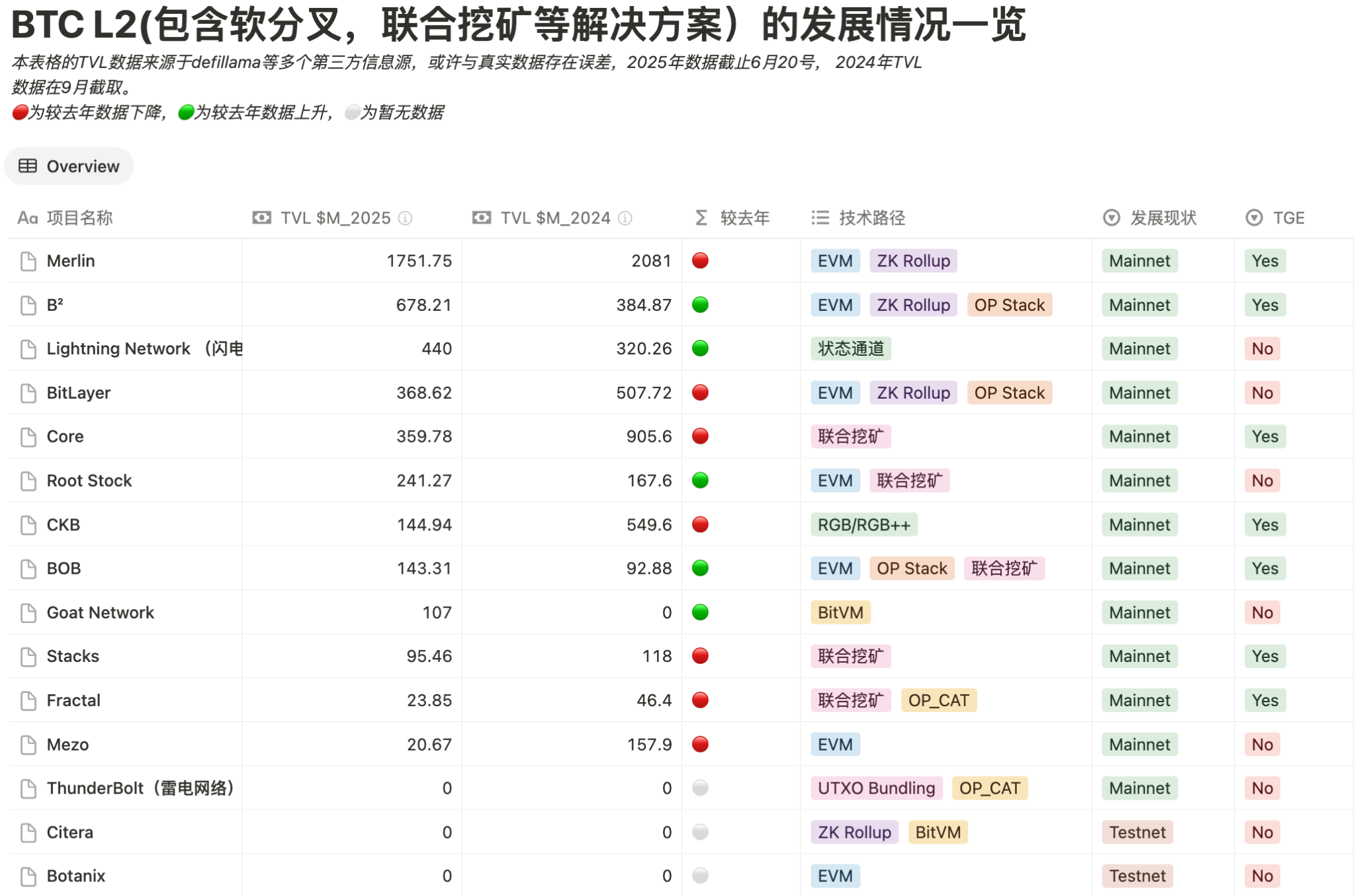
Overview of BTC L2 development, data source: https://worried-eagle-e5b.notion.site/BTC-21b34b2a8d7a80cb83c1d0021e3a5696
It can be seen that the TVL of most L2s has significantly decreased due to market influences. Additionally, although the TVL data of the Lightning Network has increased compared to last year, the amount of BTC locked in the Lightning Network this year is undoubtedly lower than last year's.
Overview of Different Technology Paths of BTC L2
1. The Most Orthodox L2 Solution for BTC: Lightning Network
It can be said to be one of the earliest L2s on BTC. Its basic mechanism is that users create a 2-of-2 multi-signature address on-chain, building a bi-directional payment channel, and ensuring that both parties can safely settle to the main chain with the latest state after multiple off-chain interactions through a Hash Time-Locked Contract (HTLC). Throughout the process, only two transactions to open and close the channel need to be written to the main chain, while a large number of intermediate transactions are completed off-chain, significantly saving block space and improving efficiency.
However, the early Lightning Network only supported BTC as a payment currency, greatly limiting the application scenarios. To address this, Lightning Labs specifically launched the Taproot Assets protocol (hereinafter referred to as TA protocol), which supports the issuance of native assets on the BTC network while seamlessly integrating with the Lightning Network. The TA protocol is based on BTC's UTXO model and the Taproot upgrade in 2021, with asset states recorded in a Sparse Merkle Tree (MS-SMT) structure, only writing the root hash of transaction data on-chain, ensuring the cleanliness of data on the Bitcoin main chain. Additionally, TA assets can also be embedded in Lightning Network channels for rapid transfer, realizing the concept of "circulating stablecoins on the Bitcoin network."
Moreover, not only stablecoins, but RWA assets and project tokens can also be issued on BTC, and the BTC multi-asset trading network will truly be constructed with the introduction of the TA protocol.
Development Progress
As of June 2025, the Lightning Network has been online for 10 years, operating stably with over 16,000 nodes and 41,000 active channels; last year, when BTC broke $100,000 per coin, the total locked capacity had already exceeded 5,000 BTC. It currently maintains around 4,000 BTC.
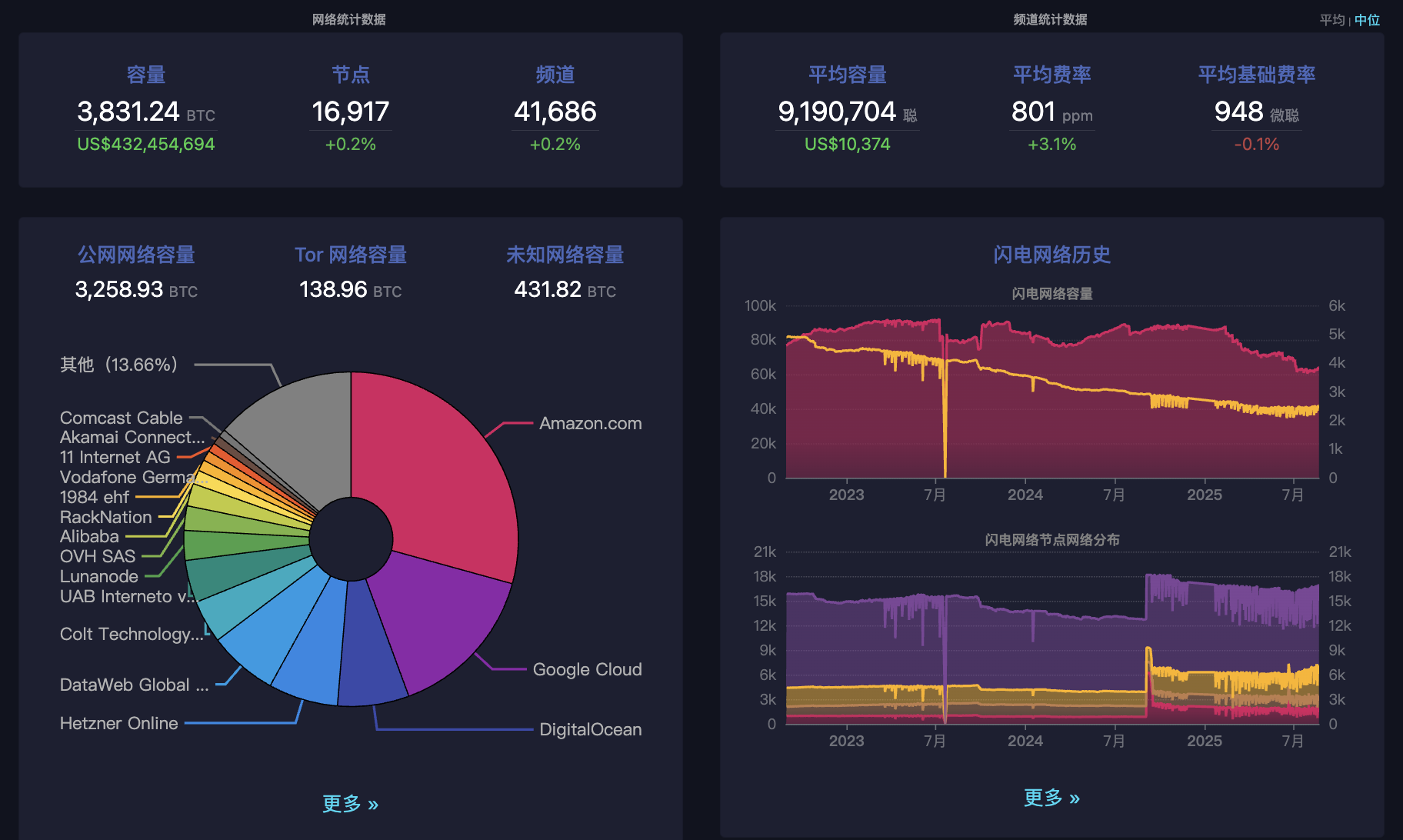
Overview of Lightning Network data, data source: https://mempool.space/zh/lightning
In Q1 of this year, Tether, the company behind USDT, announced that it would issue USDT into the Lightning Network ecosystem through the TA protocol, indicating Tether's recognition of the Lightning Network.
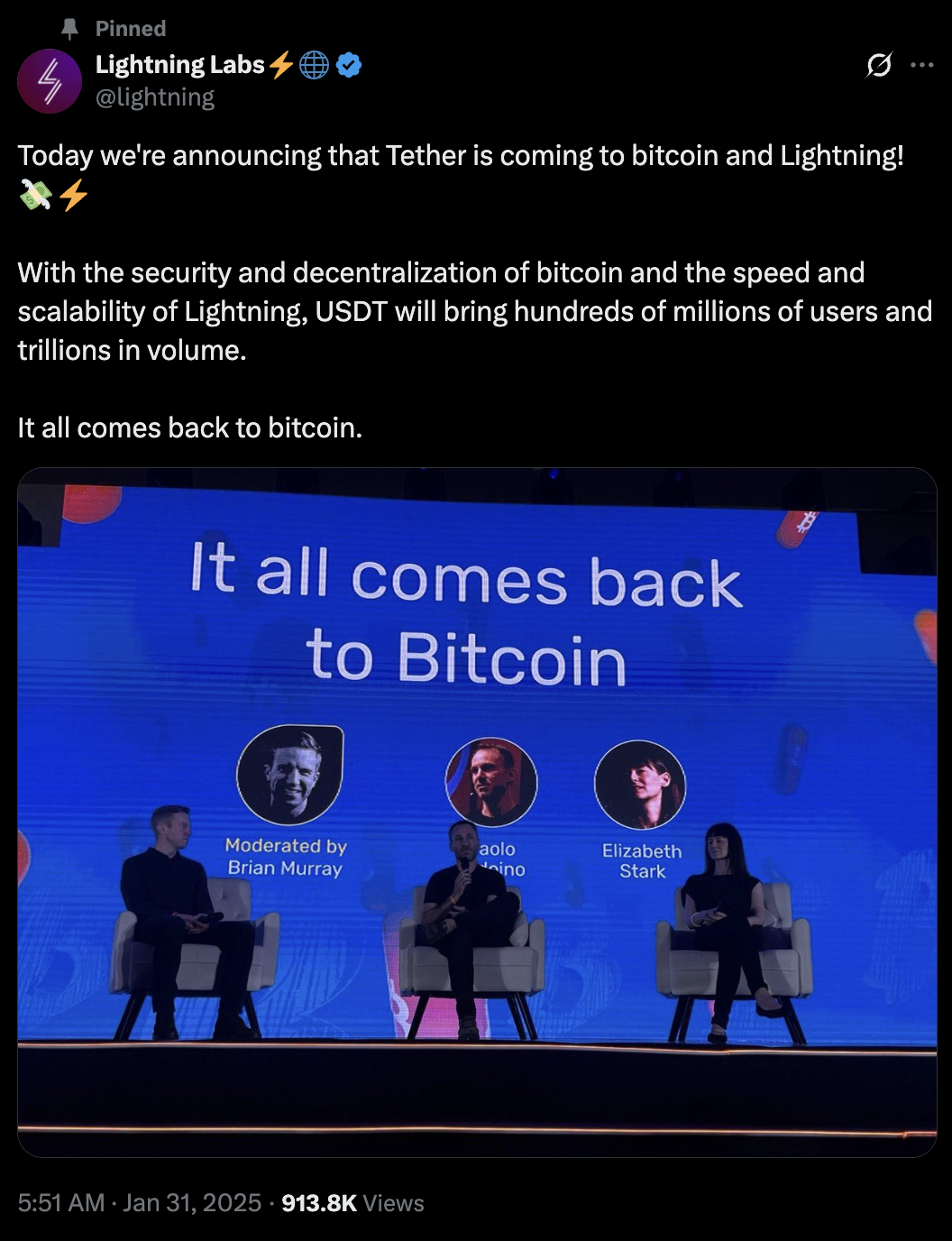
Lightning Lab (the parent company of the Lightning Network) announces Tether's integration into the Lightning Network, data source: https://x.com/lightning/status/1885083485678805424
Additionally, the ecosystem based on the Lightning Network is gradually taking shape, such as the financial infrastructure protocol Lnfi, which aims to become the preferred platform for BTC and Taproot assets, covering the entire process of asset issuance, fundraising, yield, and trading. The core product LN Exchange has a daily trading volume of $30 million, and LN Node provides over 5% trustless BTC yield. Recently, Lnfi collaborated with Tether and Lightning Labs to discuss the opportunities and challenges of issuing stablecoins on the Lightning Network in X Space.
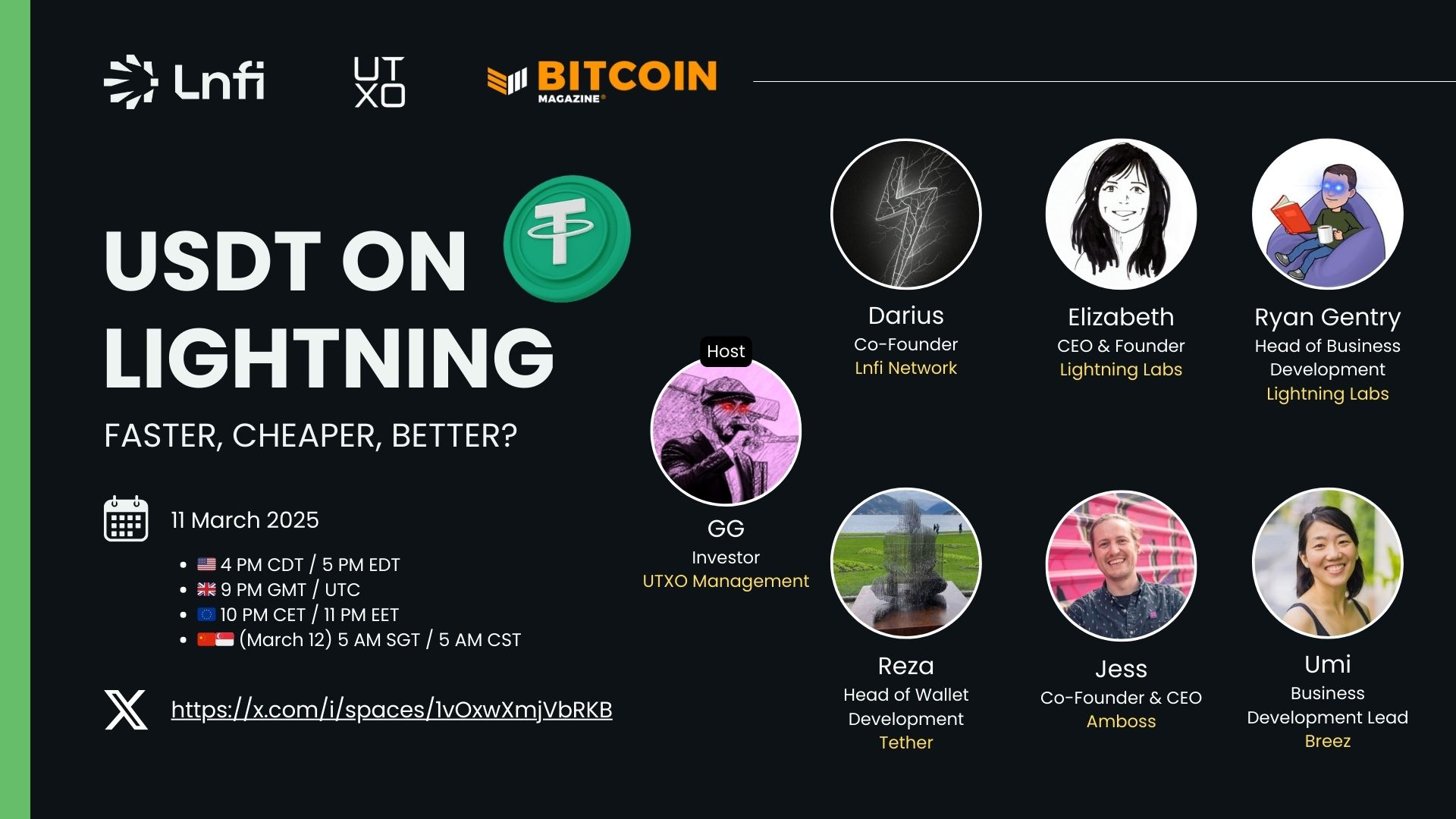
X Space of USDT ON LIGHTNING, data source: https://x.com/i/spaces/1vOxwXmjVbRKB
Furthermore, "AI Agent + Micro-Payments" is gradually building a new payment system relying on the security of the BTC network, with AIsa being a typical representative. Its principle utilizes the millisecond response characteristics of the Lightning Network and the strong security of the BTC network to solve the massive micro-transaction problem that traditional systems find difficult to support. It provides real-time, efficient, and low-cost payment capabilities for AI service providers and enterprises. AIsa supports operations such as automatic micro-payments of only $0.0001 per API call, real-time settlement of DePIN nodes, and intelligent optimization of cross-chain paths, requiring almost no human intervention.
Limitations and Challenges
Although the Lightning Network has matured significantly in recent years, its scalability is still limited by network effects and channel path design, with limited network capacity. While the TA protocol has addressed the shortcomings of the asset layer, the requirement for users to build their own nodes to ensure security raises the threshold for user participation, and the level of product completeness still needs to be resolved.
For example, BitTap provides users on the TA protocol with the right to self-custody wallets. BitTap focuses on solving the decentralization and usability issues of the Lightning Network and TA ecosystem. They have launched a decentralized browser plugin wallet and are about to launch a stablecoin payment wallet app, allowing users to make payments and transfers of stablecoins on both the Lightning Network and TA layers, while also supporting secure and free cross-layer transfers (Bridge) of stablecoins between the Lightning Network and TA layers.
2. Native Ledger Expansion: Bitcoin Thunderbolt
Just last month, the Lightning Network officially launched its mainnet, as disclosed in an official press release by HSBC. This marks the first time that a traditional financial industry authority has shown a positive response and attention to blockchain infrastructure represented by BTC.
Strictly speaking, the Lightning Network is not a traditional BTC L2; rather, it is a soft-fork compatible native ledger expansion solution based on the BTC mainnet. Its core technology lies in extending the OP_CAT instruction of the BTC scripting language, combined with UTXO Bundling technology, to achieve the execution of high-performance contracts.
Similarities and Differences with the Lightning Network:
Unlike the Lightning Network, which requires payment channels to remain open for off-chain interactions, the Lightning Network adopts a non-interactive asynchronous design, allowing users to transfer UTXO ownership off-chain without needing direct trust or continuous connection. The key lies in introducing a Byzantine Fault Tolerance (BFT) Committee to manage Schnorr signatures, enabling off-chain delegation of asset ownership and on-chain final confirmation. Under the 3f+1 model, this mechanism can tolerate up to f malicious nodes, ensuring that transactions remain secure and consistent even in an asynchronous network environment. Additionally, through UTXO Bundling technology, the Lightning Network can aggregate multiple UTXOs, achieving transaction speeds and efficiencies over 10 times that of the BTC network. In terms of asset protocols, the Lightning Network has proposed a unified standard for BTC layer assets called Goldinal, and with its developed BitMM (Bitcoin Message Market) system, it has realized a native on-chain AMM on the BTC network.
In design, the Lightning Network employs verifiable and adjustable signature components to achieve a recursive off-chain UTXO transfer structure, operating through Bitcoin Core's native logic. This acceleration mechanism, starting from the main chain architecture layer, not only maintains the security and censorship resistance of BTC but also supports the transfer of BTC native assets, including BRC-20 and Runes.
Development Progress
The Lightning Network is driven by a group of OG miners, HSBC, BTC core developers, and contributors from the Nubit community, making it one of the few protocols in the current BTC tech stack with formal academic endorsement.
Currently, the Lightning Network is only accessible to users who have obtained a Boosting Code. This code is distributed in limited quantities by core contributors like Nubit through the community and comes with rare native BTC airdrop rewards.

As of mid-June, the Lightning Network's mainnet has nearly 50,000 users, with a total transaction count approaching 4 million: Overview of Lightning Network on-chain data, data source: https://data.thunderbolt.lt/?new
Limitations and Challenges
The technology stack of the Lightning Network shows us another possibility for implementing BTC L2. Since the mainnet has not yet launched, its product PMF still needs market validation; on the other hand, although the BFT committee model is superior in security to traditional bridging solutions, whether it can gain widespread acceptance from the extremely decentralized Bitcoin community remains a question mark.
3. Merged Mining
Merged Mining is a technology that allows miners to mine multiple blockchains simultaneously without adding extra computational resources. Among them, Stacks and Fractal are two representative projects that use merged mining mechanisms, but they adopt different solutions in consensus mechanisms and block validation. Stacks uses a unique "Proof of Transfer" (PoX) consensus mechanism. In this mechanism, Stacks miners send BTC on the BTC mainnet to bid for the right to generate Stacks blocks, and successful miners receive the block packaging rights and corresponding mining rewards.
Bitflow is a DEX based on the Stacks mainnet, supporting the trading of BTC, Stacks tokens, and various BTC native assets such as BRC20 and Runes. Additionally, Bitflow launched the first Rune AMM based on Stacks in December 2024, marking the first Rune AMM on BTC L2.
Core has made slight improvements to the consensus mechanism based on merged mining: Core's consensus mechanism is called Satoshi Plus, which combines Delegated Proof of Work (DPoW) and Delegated Proof of Stake (DPoS). The specific implementation principle is that BTC miners delegate their computing power to validators on the Core chain, thereby utilizing BTC's strong mining infrastructure to provide security for the Core chain. This portion of computing power is referred to as "Delegated Proof of Work (DPoW)," executed by Bitcoin miners and mining pools; at the same time, CORE token holders can stake or delegate their tokens to validators, participating in network security maintenance and governance. This portion of rights is called "Delegated Proof of Stake (DPoS)." Through this combination, the Core Chain incorporates BTC miners into the security of Turing-complete smart contracts, unlocking these miners' functions and utilities beyond simply maintaining the BTC ledger, and providing them with pure additional income rewards in the form of CORE tokens.
Fractal adopts a scaling solution, with its technical principle being the use of a recursive expansion structure to create multiple independently operating extension layers on the BTC mainnet, forming a tree structure to improve transaction processing capacity and speed. At the same time, Fractal retains the PoW mechanism while introducing a hybrid mining mechanism called "Cadence Mining," where for every three blocks produced, two are generated through permissionless mining, and the remaining one uses BTC's merged mining.
Additionally, Fractal Bitcoin has re-enabled the OPCAT opcode, which existed in early versions of BTC but was long disabled. The function of OPCAT is to concatenate two strings into one. Theoretically, a script using OPCAT can expand 1 byte of data into over 1 TB of content. Without strict limitations, this infinite expansion characteristic could be maliciously exploited for DoS attacks, potentially overwhelming nodes or causing network congestion. For this reason, OPCAT was disabled by the community in its early days. Now, the "purified" OPCAT adopted by Fractal provides developers with a more flexible script processing method, especially showing potential in on-chain large integer calculations and smart contract functionalities. Despite improvements in the technical mechanism, the reactivation of OPCAT may still pose security risks in extreme scenarios.
Current Development Status:
Fractal Bitcoin has currently taken shape, with a market capitalization of approximately $20.12 million, a daily trading volume of 1.43M FB, and over 1.76 million active addresses. Its merged mining computing power reaches 648.13 EH/s, with a mining difficulty of 0.01t, still in the early stages.
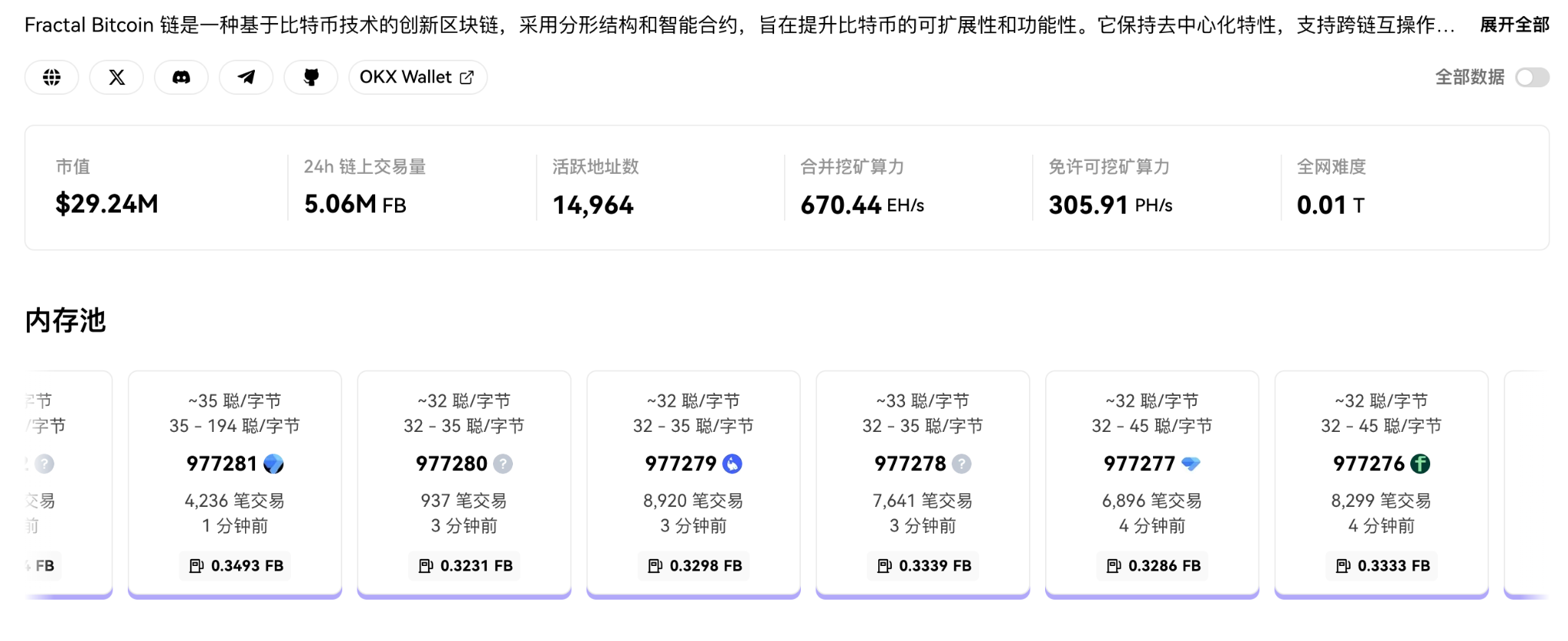
Overview of Fractal on-chain data, data source: https://www.oklink.com/fractal-bitcoin
4. RGB & RGB++
On August 7, 2025, the long-awaited BTC expansion solution RGB protocol finally launched on the BTC mainnet.
RGB originates from a technical architecture proposed by the LP/BNP Association and is an off-chain asset issuance and smart contract protocol based on the UTXO model of the BTC network. One of the most praised technical points of RGB is that the data running on RGB is compressed and encapsulated into every UTXO on the BTC network. Through "Single-use Seals" and "Client-side Validation" mechanisms, it achieves private changes and validations of asset states. Each asset state is bound to a specific BTC UTXO, and when that UTXO is spent, the asset state is updated accordingly. This design allows for ownership and state changes of assets to occur without being publicly disclosed on-chain, enhancing privacy. The RGB protocol is also compatible with the Lightning Network and has the capability to build DeFi logic.
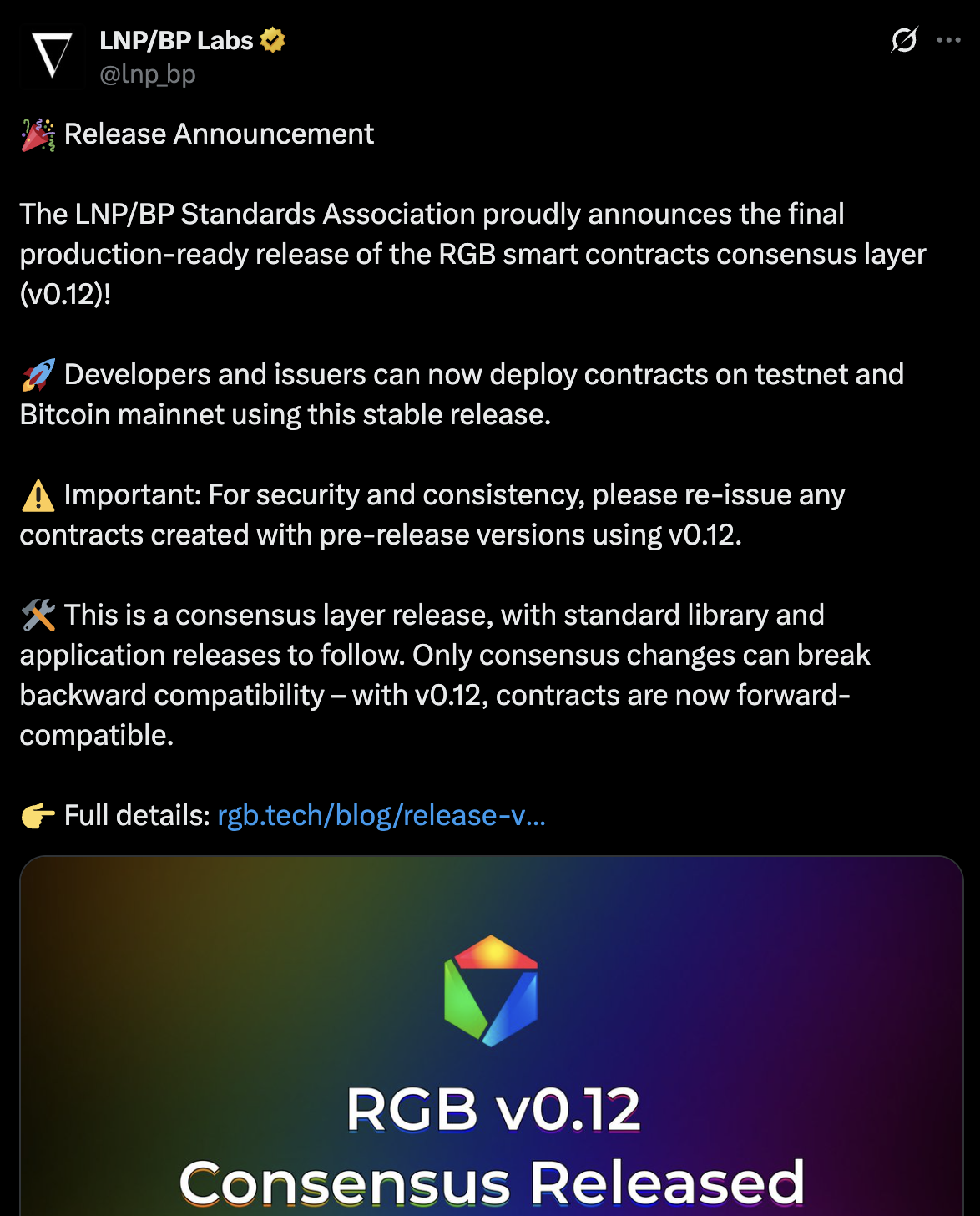
RGB version 0.12 launched, data source: https://x.com/lnpbp/status/1943318227854950809_
Bitlight Labs: The First Wallet Supporting RGB Assets, Official Member of the RGB Association
Bitlight Labs is committed to leading the original BTC Fi by developing native smart contract infrastructure for BTC and the Lightning Network. It is not only a board member of the RGB protocol standard-setting association INP/BP but also a core contributor to the development of the RGB protocol, making it an indispensable core product of the RGB ecosystem.
The product under Labs — Bitlight Wallet is a wallet specifically designed for the Lightning Network and RGB protocol. Recently, it launched the first asset token "RGB" minting event based on the RGB mainnet alongside the official launch of the RGB mainnet.
BitMask Wallet:
Bitmask is the first wallet supporting NFT assets on the RGB protocol. The team behind Bitmask is also one of the earliest contributors to the RGB protocol, focusing on privacy and user asset control in product development. Recently, BitMask has been advancing the full interoperability of RGB and RGB++, and is currently preparing for the mainnet version launch to truly achieve a combination of privacy, programmability, and usability on the BTC network.
From RGB to RGB++:
Nervos (CKB) is a popular project that implements BTC L2 using RGB logic and proposes the concept of RGB++. RGB++ introduces "homomorphic binding" technology, mapping BTC's UTXO to Nervos CKB's Cell, leveraging CKB's Turing-complete smart contract capabilities and on-chain verification mechanisms to enhance the efficiency and security of asset state management. In RGB++, asset state changes are recorded not only on the BTC chain but also have corresponding transactions and state verifications on the CKB chain, achieving collaborative verification both on-chain and off-chain.
Although RGB++ achieves asset mapping between BTC and CKB, the cross-chain interaction based on the characteristics of the RGB protocol is still not straightforward enough when handling certain specific transactions, posing security risks.
5. Following the ETH L2 Approach: ZK-Rollup
The core of Rollup lies in packaging a large number of off-chain transactions to generate cryptographic proofs (Proof) and submitting them to the main chain for verification using ZK technology.
One of the Hottest BTC L2s
Merlin is a BTC L2 network that continues this approach and is also an EVM-compatible BTC L2. Merlin adopts a multi-party computation (MPC) wallet solution, jointly managed by Cobo (a cryptocurrency custody institution in HK) for user assets. Additionally, in terms of verification technology, Merlin still uses ZK-Rollup technology, compressing a large amount of transaction data before submitting it to the BTC mainnet, ensuring the integrity and security of the data.
Since its launch on the mainnet, Merlin has become one of the most watched Layer 2 projects in the BTC ecosystem. Reports indicate that its total locked value (TVL) reached $3.5 billion within 30 days of launch, attracting over 200 projects to deploy and operate on its platform. Merlin Chain supports various BTC layer native assets, such as BRC-20, BRC-420, etc., and expands its ecosystem's breadth by being compatible with ETH.
Enhancing the Security of BTC Bridging
B² differs from traditional monolithic Rollups by adopting a "1.5 layer architecture": the Rollup layer is responsible for transaction execution and state updates, while the data availability (DA) layer operates independently and is responsible for storing raw transaction data. This data is periodically submitted to the Bitcoin mainnet after undergoing off-chain labeling and organization, achieving confirmation of finality.
The DA (Data Availability) layer of B² Network — B² Hub — belongs to Layer 1.5, where batch data is first Reed-Solomon + KZG encoded and sliced, and then the zero-knowledge proofs submitted by Layer 2 are aggregated into Taproot commitments submitted to the Bitcoin mainnet, inheriting the finality and immutability of the Bitcoin network.
B² Network employs a decentralized blob storage and light node sampling mechanism, allowing any validator to randomly sample a very small proportion of block slices to detect data completeness with high probability, significantly reducing synchronization and verification costs.
In terms of consensus, B² Hub only needs to submit short commitments and validity proofs, relieving the mainnet of the burden of large data volumes. The Rollup batch publisher is responsible for availability, forming a modular architecture of "validity outsourcing + availability guarantee." By decoupling DA from the execution layer, B² Rollup can scale in parallel and update shards while maintaining security anchored to the Bitcoin chain, balancing high throughput, low cost, and L1-level security.
This approach has two benefits: one is a modular design that allows for unlimited horizontal scaling without making any modifications or upgrades to the BTC network; the other is that through B² Network's DA layer — B² Hub, it can aggregate storage proofs and state transition proofs to submit to the Bitcoin network, integrating the security of the Bitcoin network.
However, since the final confirmation of L2 transactions requires prior confirmation and aggregation through B² Hub, followed by on-chain confirmation by the BTC network, it is considered a passive confirmation on the BTC network and operates in an optimistic mode. Additionally, the zero-knowledge proofs aggregated into Taproot commitments for optimistic verification on the BTC network are still in the POC stage and have not yet been finalized.
Project Progress: From Technical Implementation to User Ecosystem
As of now, BSquare's total locked value (TVL) has surpassed $600 million, with a peak on-chain daily trading volume reaching $900 million and 500,000 active users on the platform. The platform's ecosystem covers over 100 DApps, encompassing scenarios such as DeFi, lending, and AI Agent applications.

Overview of BSquare on-chain data, data source: https://www.bsquared.network/
Meanwhile, BSquare has also launched the first BTC yield mining pool, "Mining Square," which serves as a "savings account" for miners, providing a solution with native BTC yields. Currently, this mining pool has already captured 1% of the total network hash rate and ranks in the top 10 in terms of mining pool hash rate.
Implementing a Turing Machine with BTC Script? Decoding BitVM
BitVM is an extension protocol built on the BTC mainnet, with the core goal of supporting any verifiable computation in a general virtual machine environment without changing the consensus mechanism. Its principle draws from the idea of optimistic rollup: most computations are completed off-chain, and only in the event of a dispute are the relevant computation processes submitted on-chain in the form of "fraud proofs." Similar to Ethereum's Arbitrum, BitVM uses an off-chain computation + on-chain verification mechanism, but its uniqueness lies in utilizing Bitcoin's scripting system (Bitcoin Script) to construct "logic gate circuits," thereby simulating a Turing-complete virtual machine (similar to the human computer in the Three-Body game).
BitVM does not directly run EVM or WASM on-chain but translates these high-level virtual machine operations into combinations of the most basic logic gates (such as AND, OR, NOT, etc.) in Bitcoin scripts, constructing a massive "fraud verification circuit." All transaction data and computations are processed off-chain, and only when a challenge occurs are the data and computation steps (in the form of Merkle Proofs, etc.) submitted on-chain.
BitVM2 is an optimized version of the original BitVM, introducing a more modular computation structure and circuit compression mechanism, while also incorporating interactive fraud proofs, time-lock scripts, multi-signature mechanisms, and other features to enhance the protocol's practicality and security. BitVM2 places greater emphasis on optimizing on-chain data submission volume and attempts to introduce script opcodes like OP_CAT that may be activated in the future to improve circuit construction efficiency.
Current Development Status
Currently, the BitVM roadmap is gradually transitioning from theory to practice, with a representative project being Citrea, which executes a large number of transactions off-chain and submits the execution results and proofs to the BTC network for verification through BitVM. This has achieved efficient scaling and security for BTC L2. Citrea is also the first solution capable of achieving general L2 settlement on BTC, with all proofs verified natively within the blocks on the BTC network. As of now, Citrea's mainnet has not yet officially launched and is still in the testnet phase.
Projects like Goat Network are exploring the possibilities of BitVM2. Goat's white paper showcases a fraud proof mechanism based on circuit logic and Merkle tree structures. Goat emphasizes expanding computation on BTC into a Turing-complete state machine and attempts to construct a new BTC L2 framework that allows smart contract execution and asset interaction to be natively completed on the Bitcoin main chain. Goat's implementation also includes the integration of a data availability layer (DA layer) and optimizations for circuit compression mechanisms, pushing BitVM from an experimental solution towards practical deployment. As of June this year, Goat Network's locked value has surpassed $100 million.
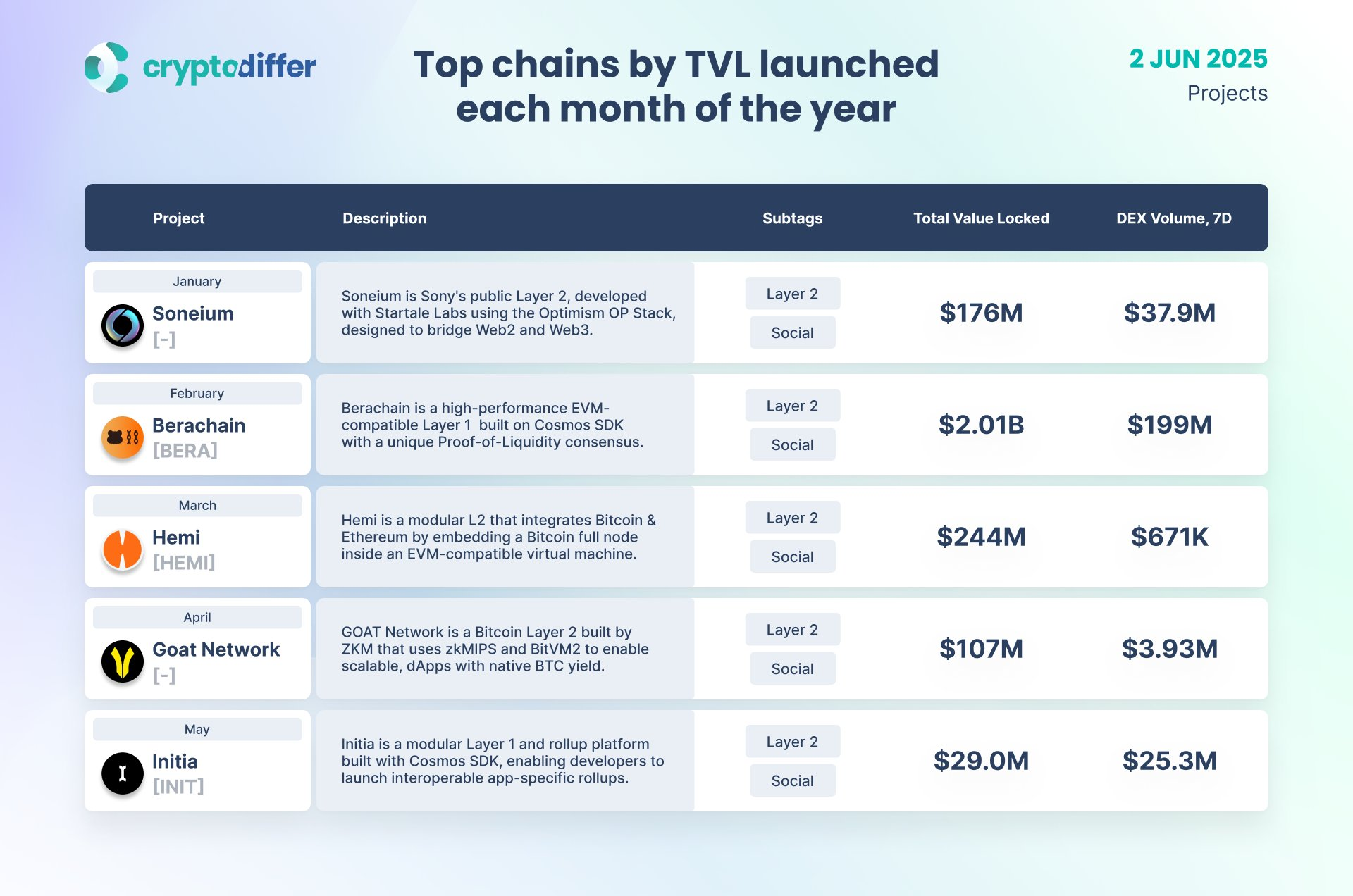
Top chains by TVL launched each month of the year, CryptoDiffier; data source: https://x.com/GOATRollup/status/1929596963286114614
Despite the clear advantages of the BitVM series of protocols: extreme native capabilities, achieving Turing-complete computation without changing the BTC consensus, and possessing high security and native properties; its structure inherently supports fraud proofs, low data on-chain rates, and extreme decentralization.
However, the disadvantages of BitVM stem from its technology: the logic gate circuits constructed from BTC Script to simulate EVM or WASM will be epic in complexity and size, making the development complexity of BitVM extremely high and the workload for circuit construction very large. Additionally, there is currently a lack of a mature developer ecosystem and standardized tools.
Multiple Paths Forward, the Battle for Value Carrying is Still Unresolved
Each solution for BTC L2 has its own technical focus. For example, the Lightning Network focuses on payment efficiency and has developed a mature node network suitable for micropayments and off-chain settlements over years. RGB and RGB++ pay more attention to asset security, utilizing client-side verification mechanisms to ensure asset states. The ZK-Rollup route, mostly adopting mature EVM solutions + modular security verification, currently possesses strong composability and cross-chain expansion capabilities, adapting more quickly to scenarios like DeFi and AI Agents. BitVM further pursues extreme native capabilities, achieving smart contract functionality on-chain without altering the BTC consensus, representing an extreme attempt at BTC's computational capabilities, even though it is still in its early stages.
Although it is not yet determined, we can see that a truly viable long-term solution must strive to meet three points: BTC native compatibility, verifiable security, and good support for upper-layer applications. Moreover, the trend of technology stack integration is becoming increasingly evident, such as the combination of the Lightning Network with stablecoins and the exploration of integration between ZK Rollup and RGB.
In the future, BTC L2 will certainly be characterized by a multipolar competitive landscape, with different solutions serving various core scenarios: payments, contracts, assets, storage, AI, etc., collaborating to support the long-term prosperity of the BTC ecosystem. This competition is far from over, and the true winner will be determined by asset accumulation capabilities and the developer ecosystem. As the world's strongest consensus asset, BTC's ecological boundaries will continue to expand due to the influx of USD stablecoins and modular innovations in L2, ushering in a "payment sovereignty + contract expansion" dual upgrade.
Recently, with the implementation of the US GENIUS stablecoin bill, it marks a gradual clarification and improvement of global stablecoin regulation. "Payment stablecoins" have been legally incorporated into the USD system, which is expected to drive the acceleration of on-chain payment scenarios for other emerging stablecoins, including USDT and USDC. As Tether's CEO pointed out, emerging markets are the main battleground for stablecoin adoption, with 60% of USDT's growth coming from actual payment demands outside the crypto circle.
The GENIUS bill provides a clear legal pathway for the on-chain use of stablecoins and opens a compliance channel for BTC L2 to carry USD assets. USDT, as the first stablecoin born on the BTC network, is now leading the way back into the BTC ecosystem. This not only represents a return to the technical route but also reflects BTC's strategic value as a settlement layer. It is foreseeable that if a stablecoin payment system is built on BTC L2 in the future, it will be the most native, secure, and aligned with the spirit of Bitcoin. With the composability and asset protocol capabilities of BTC L2, the BTC network is expected to accommodate the payment settlement needs of the real world, achieving a symbiotic pattern where stablecoin circulation and value accumulation coexist.
References:
https://eprint.iacr.org/2025/709
https://riema.notion.site/Bitcoin-Thunderbolt-1d7f5aa90cdd803b8a73d080c83af098
https://x.com/kevinliub/status/1919499375035756580?s=46
https://www.theblockbeats.info/flash/289746
https://lbank-exchange.medium.com/rgb-protocol-a-promising-approach-for-asset-issuance-on-the-bitcoin-network-after-brc20-357bd74f0c4c
https://mp.weixin.qq.com/s/iMQPXFPWBpT9dQLyR8rzUg
https://www.btcstudy.org/2023/09/12/the-potential-of-RGB-protocol/
https://mp.weixin.qq.com/s?__biz=Mzk0OTYwMDM1Mg==&mid=2247487024&idx=1&sn=0241778d2e1fbed796a6beaeb3c07c4a&chksm=c21c27cca1e00c1d214dc01d1b6368b8e9198afa94d4bc16d5b5e1dadbd9402dd029a87747e9&scene=132&exptype=timeline_recommend_article_extendread_samebiz#wechat_redirect
https://www.binance.com/zh-CN/square/post/23302994992353
免责声明:本文章仅代表作者个人观点,不代表本平台的立场和观点。本文章仅供信息分享,不构成对任何人的任何投资建议。用户与作者之间的任何争议,与本平台无关。如网页中刊载的文章或图片涉及侵权,请提供相关的权利证明和身份证明发送邮件到support@aicoin.com,本平台相关工作人员将会进行核查。



